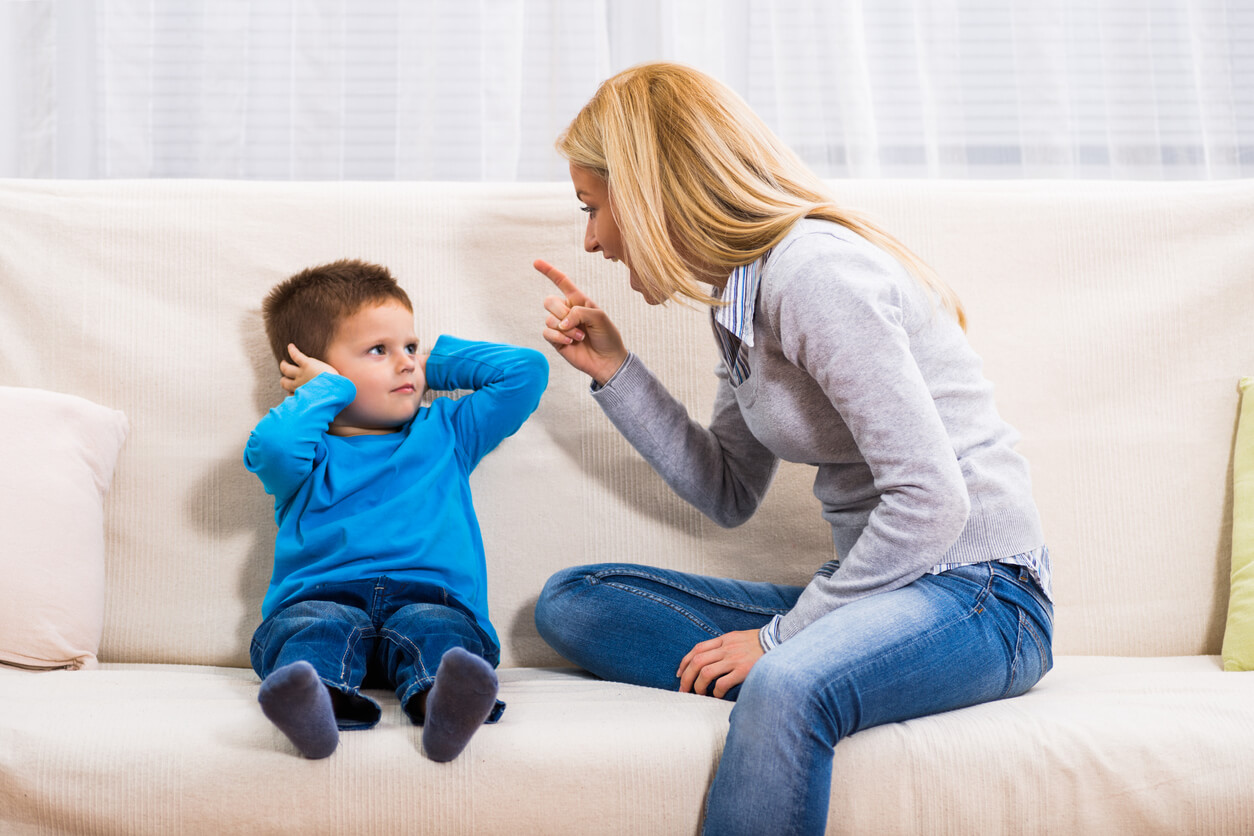Good Inside, A New Parenting Method


Written and verified by the psychologist Elena Sanz Martín
Millennial parents often do a great job of breaking away from traditional parenting methods that weren’t at all positive for the emotional development of children. They’re more conscious parents who seek to be informed and try to improve every day to offer their children the best conditions in which to grow up. If you’re one of them, you’ll be interested to know about an innovative educational proposal known as Good Inside, which is based on a premise as simple as it is powerful: “We’re all good on the inside”.
The strength of this message lies in the fact that it helps us to change our perspective. When your child screams nonstop or throws their toys, remembering their inherent goodness will help you take a breath and reflect before you act. And the same will happen when you lose your temper or feel overwhelmed because remembering your own goodness will allow you to not be so hard on yourself.
If you want to know more about this pedagogical approach and how to put it into practice, we invite you to keep reading.
Good Inside, more than positive parenting
The method we’re talking about today was created by Becky Kennedy, a clinical psychologist, and true educational guru. This American doctor, mother, and parenting expert began sharing valuable information on her networks when she had barely 200 followers. Since then, her particular approach has become a complete educational method that’s already known and followed by almost one and a half million parents around the world.
Her entire parenting model is embodied in her book Good Inside, and has been especially popular among new generations due to its rigorous and human approach. Below, we’ll share with you the principles of the Good Inside model.

Self-knowledge is the basis of parenting
The first proposal we find in this model is to start by getting to know ourselves. As a parent, you need, perhaps, to re-educate yourself before addressing your child. Many times, we didn’t receive the best upbringing in our own childhood, we didn’t acquire the necessary emotional tools, and we weren’t treated properly. Therefore, from this position, we’ll most likely continue with a repetition of patterns.
Therefore, the work begins with you as an adult, making you aware of how you were raised, and what you lacked, and work on acquiring it now. When you’ve gone through this process, you’ll be much more aware and ready to become the parent you want to be.
We’re all good inside
This is the main premise of Becky Kennedy’s approach. The idea that we’re all “good on the inside” is the idea that we need to engrave in our minds. Our children are good by nature, regardless of whether they have bad days or if at certain times their behavior isn’t the most appropriate or desirable.
Having this clear will help us to understand that behind every bad behavior, there’s a message that we must listen to. And the fact is that no child misbehaves on purpose, but this is usually the result of an emotion that they don’t yet know how to manage or a skill that they haven’t yet acquired and need our help.
So, when your child has a tantrum, hits their brother, or doesn’t obey you the first time you tell them to do something, stop, breathe, and reflect. Put yourself in their place. Maybe their behavior shows you that they’re feeling anxious and don’t know how to regulate themself, that they feel jealous, or that they don’t yet know how to control their impulses. From this understanding, you’ll be able to accompany and guide them much better.
Educate without fear
Current educational proposals based on love and respect aren’t permissive approaches. Good Inside emphasizes the need to set limits for children but in a humane, fair, and empathetic way.
What does this mean? That we’ll no longer educate out of fear or through punishment, threats, or blaming. It means that when we address children, we’ll do it in search of their welfare and learning, and not as a mere automatic act to release our frustration.
The limits must be a guide that shows the child the right direction, helping them to understand why, and to internalize the values behind that rule. Fair, consistent, and proportionate consequences educate, while fear only produces resentment.

The importance of teaching tools to our children
Another fundamental key of the Good Inside model is related to children’s emotions. Every parent wants their children to be happy, but to achieve this, we must allow children to go through and explore all emotions.
Sometimes we overprotect them to avoid exposing them to frustration, anger, or sadness. Other times, we invalidate their emotions, urging them to stop crying or telling them it’s not that big of a deal because we’re uncomfortable with their discomfort.
However, if you really want your child to be happy, the most important task is to teach them to manage all those emotions that they’ll inevitably feel throughout their lives. And to do this, you have to allow them to express these emotions, help them to understand them and name them, and teach them tools and resources to deal with them.
Good Inside doesn’t expect perfection from parents
A final point to consider is that you’re not expected to be a perfect mother or a flawless father. We’re all human and we’re all entitled to falter or make mistakes. However, making this shift in perspective, understanding that we’re all good on the inside, and appealing to this truth when parenting is invaluable.
It’s important that, as a parent, you also take care of yourself, your well-being, and your emotional health. Don’t just focus on your children or make sacrifices for them. You’re their best example of how to deal with stress, challenges, and difficulties in life. So, try to be your best self, take care of yourself, learn your own tools, and apply them. This way, you’ll be in a better position to provide appropriate parenting.
Strengthen your relationship with your child
In short, Good Inside is an approach that will strengthen your relationship with your child and allow you to teach them what they need to know to be emotionally successful in life. Although this style of parenting requires a lot of effort and thought, the fruits it offers are of great value.
Millennial parents often do a great job of breaking away from traditional parenting methods that weren’t at all positive for the emotional development of children. They’re more conscious parents who seek to be informed and try to improve every day to offer their children the best conditions in which to grow up. If you’re one of them, you’ll be interested to know about an innovative educational proposal known as Good Inside, which is based on a premise as simple as it is powerful: “We’re all good on the inside”.
The strength of this message lies in the fact that it helps us to change our perspective. When your child screams nonstop or throws their toys, remembering their inherent goodness will help you take a breath and reflect before you act. And the same will happen when you lose your temper or feel overwhelmed because remembering your own goodness will allow you to not be so hard on yourself.
If you want to know more about this pedagogical approach and how to put it into practice, we invite you to keep reading.
Good Inside, more than positive parenting
The method we’re talking about today was created by Becky Kennedy, a clinical psychologist, and true educational guru. This American doctor, mother, and parenting expert began sharing valuable information on her networks when she had barely 200 followers. Since then, her particular approach has become a complete educational method that’s already known and followed by almost one and a half million parents around the world.
Her entire parenting model is embodied in her book Good Inside, and has been especially popular among new generations due to its rigorous and human approach. Below, we’ll share with you the principles of the Good Inside model.

Self-knowledge is the basis of parenting
The first proposal we find in this model is to start by getting to know ourselves. As a parent, you need, perhaps, to re-educate yourself before addressing your child. Many times, we didn’t receive the best upbringing in our own childhood, we didn’t acquire the necessary emotional tools, and we weren’t treated properly. Therefore, from this position, we’ll most likely continue with a repetition of patterns.
Therefore, the work begins with you as an adult, making you aware of how you were raised, and what you lacked, and work on acquiring it now. When you’ve gone through this process, you’ll be much more aware and ready to become the parent you want to be.
We’re all good inside
This is the main premise of Becky Kennedy’s approach. The idea that we’re all “good on the inside” is the idea that we need to engrave in our minds. Our children are good by nature, regardless of whether they have bad days or if at certain times their behavior isn’t the most appropriate or desirable.
Having this clear will help us to understand that behind every bad behavior, there’s a message that we must listen to. And the fact is that no child misbehaves on purpose, but this is usually the result of an emotion that they don’t yet know how to manage or a skill that they haven’t yet acquired and need our help.
So, when your child has a tantrum, hits their brother, or doesn’t obey you the first time you tell them to do something, stop, breathe, and reflect. Put yourself in their place. Maybe their behavior shows you that they’re feeling anxious and don’t know how to regulate themself, that they feel jealous, or that they don’t yet know how to control their impulses. From this understanding, you’ll be able to accompany and guide them much better.
Educate without fear
Current educational proposals based on love and respect aren’t permissive approaches. Good Inside emphasizes the need to set limits for children but in a humane, fair, and empathetic way.
What does this mean? That we’ll no longer educate out of fear or through punishment, threats, or blaming. It means that when we address children, we’ll do it in search of their welfare and learning, and not as a mere automatic act to release our frustration.
The limits must be a guide that shows the child the right direction, helping them to understand why, and to internalize the values behind that rule. Fair, consistent, and proportionate consequences educate, while fear only produces resentment.

The importance of teaching tools to our children
Another fundamental key of the Good Inside model is related to children’s emotions. Every parent wants their children to be happy, but to achieve this, we must allow children to go through and explore all emotions.
Sometimes we overprotect them to avoid exposing them to frustration, anger, or sadness. Other times, we invalidate their emotions, urging them to stop crying or telling them it’s not that big of a deal because we’re uncomfortable with their discomfort.
However, if you really want your child to be happy, the most important task is to teach them to manage all those emotions that they’ll inevitably feel throughout their lives. And to do this, you have to allow them to express these emotions, help them to understand them and name them, and teach them tools and resources to deal with them.
Good Inside doesn’t expect perfection from parents
A final point to consider is that you’re not expected to be a perfect mother or a flawless father. We’re all human and we’re all entitled to falter or make mistakes. However, making this shift in perspective, understanding that we’re all good on the inside, and appealing to this truth when parenting is invaluable.
It’s important that, as a parent, you also take care of yourself, your well-being, and your emotional health. Don’t just focus on your children or make sacrifices for them. You’re their best example of how to deal with stress, challenges, and difficulties in life. So, try to be your best self, take care of yourself, learn your own tools, and apply them. This way, you’ll be in a better position to provide appropriate parenting.
Strengthen your relationship with your child
In short, Good Inside is an approach that will strengthen your relationship with your child and allow you to teach them what they need to know to be emotionally successful in life. Although this style of parenting requires a lot of effort and thought, the fruits it offers are of great value.
All cited sources were thoroughly reviewed by our team to ensure their quality, reliability, currency, and validity. The bibliography of this article was considered reliable and of academic or scientific accuracy.
- Aguirre, E., Montoya, L. M. y Reyes, J. A. (2006). Crianza y Castigo Fisico. En Aguirre, E. Diálogos 4. Discusiones en la Psicología Contemporánea. Bogotá, D. C. (Colombia): Universidad Nacional de Colombia, Facultad de Cien.
- Kennedy, B. (2022). Educar sin miedo: Conviértete en la madre o el padre que quieres ser (1.a ed.). Planeta.
This text is provided for informational purposes only and does not replace consultation with a professional. If in doubt, consult your specialist.








